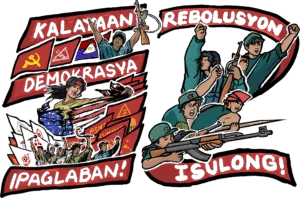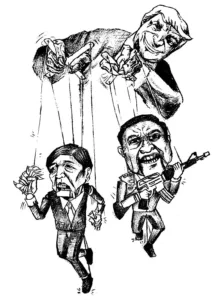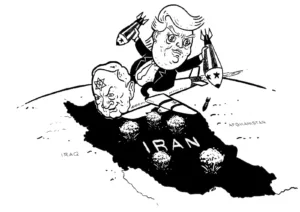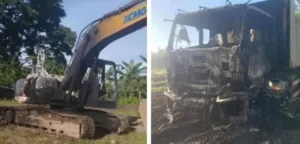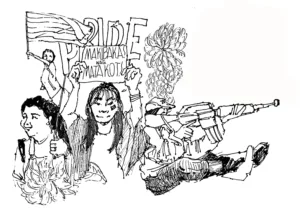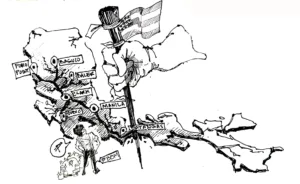Remembering the First Quarter Storm of 1970
We observe this year the 100th anniversary of the 1986 Philippine Revolution against Spanish colonization, and the 26th anniversary of the First Quarter Storm of 1970. The two are interrelated, and are historic events to the Filipino people since both had to do – and still have to do – with our people’s continuing struggle for national independence and democracy.
We honor the 1986 Revolution as the collective, united effort of our patriotic and democratic forebears in the Katipunan to rise up in arms to finally liberate our country from more than 300 years of Spanish colonial rule. With heads high, we do honor this historic event – even if it was frustrated especially by the errors of the ilustrado leadership and by the deception, the aggression and the ferocity of US imperialismwhich grabbed colonial control over our country and people.
While we pay tribute to the bravery and dedication of the worker Andres Bonifacio, founder of the Katipunan, and of his comrades-in-arms, we, as today’s revolutionaries, study their experience and learn from the positive and negative lessons, even as we also learn from the more recent experiences of revolutionaries in other part of the world.
The Katipunan Revolution of 1896 whose centenary we celebrate this year and the national democratic revolutionary struggle we are waging today have the same general objective: to achieve, safeguard and advance the national and democratic interests of the Filipino people.
Having pointed that out, we must also underscore the fact that the 1896 Revolution had a bourgeois-democratic theoretical grounding. Our revolution of today is under the superior working class revolutionary theory which, in 1896, was still undergoing refinement especially in Russia. Even so, our revolutionary struggles today are a continuation of the unfinished revolution of 1896, with a clear socialist goal.
The First Quarter Storm of 1970, which belongs closer to my generation, is more directly connected with today’s new-democratic revolution being waged by the allied mass organizations in the National Democratic Front of the Philippines (NDFP) which continue to fight for the national and social emancipation of the Filipino people.
Looking back through the last 26 years to the FQS of 1970, one harkens to a time of cerebral and physical ferment, a time of trepidation and courage, a time of study and education, a time for the heightening of political consciousness, a time to make crucial decisions affecting one’s life, going full-time into revolutionary work.
I was a journalist at that time, having been trained to be an “objective” observer of the day-to-day life of our society. I should have appraised the events of the FQS with some degree of “objectivity” and “impartiality”, as my elders in newspapering would like to say. But like many of the students, workers and peasants at that time, and like some journalists and other professionals as well, I, too, went through a process of political awakening. In my ensuing political conduct, I was not to be “impartial”. I was to be partial to the cause of the broad masses of our people.
For me, it is difficult to think back, exclusively to the political events in the first three months of 1970 – the FQS. Like others, I also tend to look back to political events, of say, the previous year, 1969, which after all, helped prepare for, and culminate in, the FQS (actually, according to Comrade Jose Maria Sison, I took a whole decade to prepare for the FQS); I also tend to look beyond the FQS – to the political events of the rest of 1970, 1971 and up to 1972 (declaration of fascist martial law) which came as further development of the FQS.
The scene is January 1970. The political circus that was the presidential election of November 1969 had just been held, and the reelectionist Marcos soundly beat his opponent, Sergio Osmena, Jr., a puppet of US imperialism as Marcos himself was. Did Marcos enjoy great popularity among the people? The answer is no.
In fact, with the coming of 1970, Marcos and his US imperialist masters decreed a devaluation of the peso (from P3.90=US$1, to P6=$1) to increase the value of imperialist investments and property in the Philippines, and aggravate the livelihood of the people whose income was not being increased. The drastic devaluation thus farther aggravated the economic and political crisis of the ruling system in the Philippines.
That is why on Jan. 26, 1970, a large mass action of the youth and students in front of the Philippine Congress had a ready-made issue: they were there to confront Marcos on his state-of-the-nation address to Congress, and to expose him for his continuing subservience to US interests.
The area in front of Congress was swollen by the student youth and worker youth of Kabataang Makabayan (Patriotic Youth-KM) when Marcos, after his message to Congress exited nearby. Suddenly, some people flung a big papier-mache figure of a crocodile symbolizing the corrupt big bureaucrats, and a papier-mache representation of a coffin symbolizing the death of national freedom, if my memory serves me right. Then all hell broke loose. With truncheons, policemen and military troops flailed every which way, hitting out at the radikal kabataan (radical youth) of KM. Many were hurt and many were arrested.
Thus, a few days later, on Jan. 30, the youth and students of the KM and other national democratic organizations went out on the streets again, this time to demonstrate in front of Malacanang Palace to protest the brutal dispersal of the Jan. 26 rally. This was a more indignant rally than the first one, with the youth and students standing their ground against the state’s armed goons’ truncheons, teargas, water cannons and gunfire. The rally lasted until the early-morning hours of Jan. 31, when the state goons had killed six of the demonstrators and injured several hundreds of others.
To the marching youth, and to the people at large, this signalled the growing desperation of the ruling system against the rising masses. But undaunted by the mass killing of their six comrades, this gave the awakened youth the impetus to expand to the provinces and to stage more demonstrations on an expanding scale. This process went on until the end of March – the Sigwa ng Unang Kwarto ng 1970, the FQS – and beyond.
The upsurge in the national democratic movement’s mass actions served to expose and oppose a rotting system where US imperialism, feudalism and bureaucrat capitalism held sway. The movement also served to propagate the program of the national democratic movement which was meant to replace the old and decaying one.
The mass movement was also a school to help prepare the cadres and mass activists in confronting the enemy. In that sense, each mass action was a learning process for the participants. In between those marches, there were as well informal studies on revolutionary theory. This was undertaken individually or by discussion groups (the “DGs”). Education was further undertaken by integrating with the worker and peasant masses.
If memory serves me right, the reading materials, or “RMs”, at that time, included fresh documents of the CPP’s reestablishment which repudiated Lavaite revisionism; the CPP’s Ang Bayan, Jose Maria Sison’s Struggle for National Democracy, and Chairman Mao Zedong’s selected writings and the Red Book. Five Golden Rays, which inspired many people, came from Mao’s writings. Amado Guerrero’s Philippine Society and Revolution was being prepared for printing.
The demonstrations had to increasingly confront the state’s forces of coercion, especially those assembled in the PC Metropolitan Command (Metrocom), who used the gun almost as frequently as truncheons, teargas and water cannons. Thus, one could all the more easily comprehend Lenin’s State and Revolution, and accept armed revolution as the answer. And in integrating with, say, the worker masses, living with them and struggling with them at the picket line, one could more easily see their sense of exploitation and oppression, and their receptivity to scientific socialism.
The FQS was a time for courage. Increasingly confronting the enemy’s guns (as in the case of Jan. 30-31), one drew strength and guts from the synergy of the tens of thousands who were one’s comrades, and those cheering you on. One dared to do anything! “Makibaka! Huwag matakot!” (Fight on! Have no fear!) resounded over and over again on the streets. And to help educate the masses, and to put fear into the hearts of the enemy, “Ano ang sagot sa martial law?” (What is our response to martial law?), “Digmaan, digmaan, digmaang Bayan!” (War, war, people’s war!).
In the expansion nationwide, there was now a proliferation of new mass organizations (MOs): Katipunan ng mga Samahang Manggagawa (Kasama) and Pambansang Kilusan ng mga Manggagawa (Pakmap), among the workers; the Malayang Kilusang ng Bagong Kababaihan (Makibaka), among the women; the Samahan ng Demokratikong Kabataan (SDK) and the Katipunan ng Kabataang Demokratiko (KKD), among the youth; the Kapisanan ng mga Gurong Makabayan (Kaguma), among the teachers; the Christians for National Liberation (CNL), among the clergy and church people; Panulat para sa Kaunlaran ng Sambayanan (PAKSA), among literary people; the Nagkakaisang Progresibong Artista-Arkitekto (NPAA), among artists and architects; the Samahan ng mga Progresibong Propagandista (SPP), the League of Editors for a Democratic Society (LEADS) and the revived College Editors’ Guild of the Philippines (CEGP), among campus editors, and many others.
Expansion teams from these MOs were spreading out among the various colleges and universities of Metro Manila and to the provinces. To coordinate and direct this growing number of allied organizations, there came the Movement for a Democratic Philippines (MDP). Elsewhere in Metro Manila, activists displayed resourcefulness by boarding buses and distributing manifestoes and statements to the passengers. Or, welcoming the invitation of enlightened teachers, they went from schoolroom to schoolroom to rally the students to the Red flag of struggle.
Since it was the orientation of the youth and student movement to deploy prospective cadres and activists to integrate with the peasant masses, the youth who were now politically conscious – and those who ere getting “hot” (umiinit) in the urban areas – were being deployed to the countryside.
They went there to become political officers (Pos) of the newly formed squads and platoons of the New People’s Army, and to organize the peasants. In Manila at that time, it became common dialogue for a comrade to ask another about a “missing” comrade. The reply was that he was already in “I”. This meant he had gone to the hills in the new expansion areas of Isabela (“I”), in Northeastern Luzon. Or later, to the other expansion areas in Southern Tagalog or Bicol, or farther south to the Visayas and Mindanao.
As a result of the FQS, the National Press Club (NPC) of the Philippines, of which I was president, passed a resolution at its 1970 National ConventionChinese Commercial News who were persecuted and deported to Taiwan by the Marcos regime and its Kuomintang cohorts, and supporting the young staffers of the Dumaguete Times in the Visayas who were being held incommunicado by the regime. We also opened the door of the NPC to mass leaders and activists of the national democratic movement to acquaint them with the reporters covering the surging mass movement, and to extend to them whatever physical protection the press club had at that time. aligning the NPC in the movement for national independence and democracy. This was after my first term as president, where we took the progressive course of supporting the brothers Rizal and Quintin Yuyitung of the
When I look back to the FQS of 1970, what stands out in my mind are the positive contributions that that period and its political activities contributed to the national democratic revolution as a whole. Among the things that I remember most was the spirit of learning that pervaded the mass activists, and their sense of courage.
If we remember, the FQS was launched in the wake of the First Great Rectification Campaign, to repudiate the revisionism of the Lavaite renegades and to propagate the national-democratic line. Today, we are going through the Second Great Rectification Campaign, to repudiate revisionism, splittism, capitulationism and reformism of present-day revisionists.
In the FQS, the call was for the political and theoretical education of the young and their deployment to the countryside. Today, with the Second Great Rectification Campaign, there is a call for education on the rectification documents and on the varied levels of theoretical education, especially on Mao Zedong and our own rich experiences.
I’m happy to learn that it was in the ranks of the youth and students and workers – as in the case of the FQS – that the rectification campaign took root, and that it was the youth and the workers who took up the cudgels for the movement and its program, as against the deviations of the revisionists and splittists.
I understand, too, that as in the FQS, it is again among the youth and students and the workers that the call is being heeded for the educated and politically conscious youth to integrate with the peasant masses in the countryside, instead of being kept in the urban areas for possible insurrectionist activities.
As this trend continues, and as we carry on the rest of our tasks at the present time, we keep faith with our forebears who launched the Katipunan Revolution of 1896, and we keep faith with present-day Filipinos, especially the thousands of comrades who – before, during and after the FQS – willingly sacrificed their lives against the US-Marcos fascist dictatorship, the US-Aquino fascist regime and now the fascist regime of the US-Ramos clique, so that our children and our children’s children will live in national freedom, democracy, peace, justice and prosperity.
* The article was first published in the January-February 1996 issue of Liberation International. We are publishing it once again to commemorate the 40th anniversary of the First Quarter Storm.
